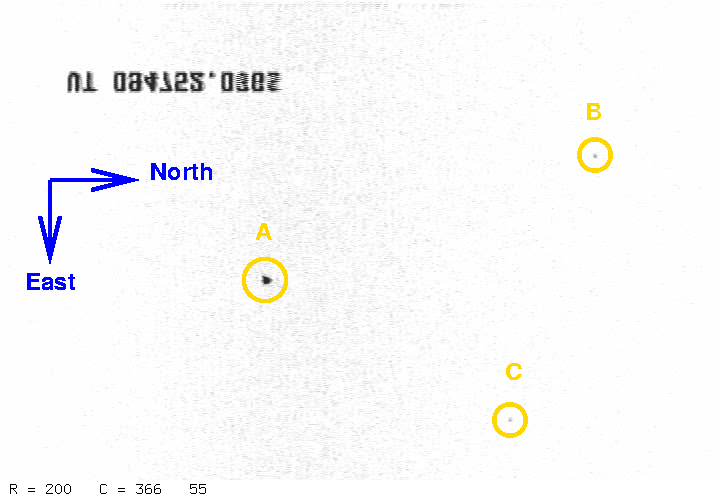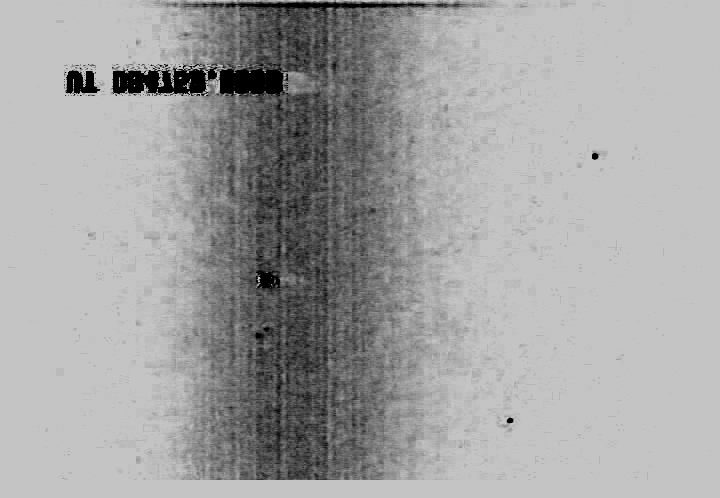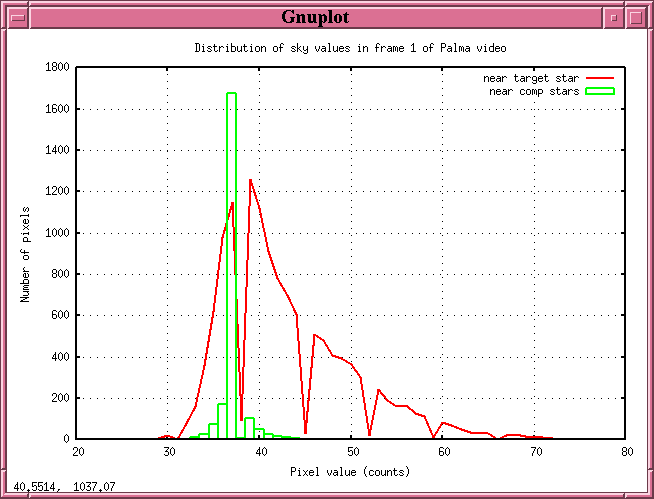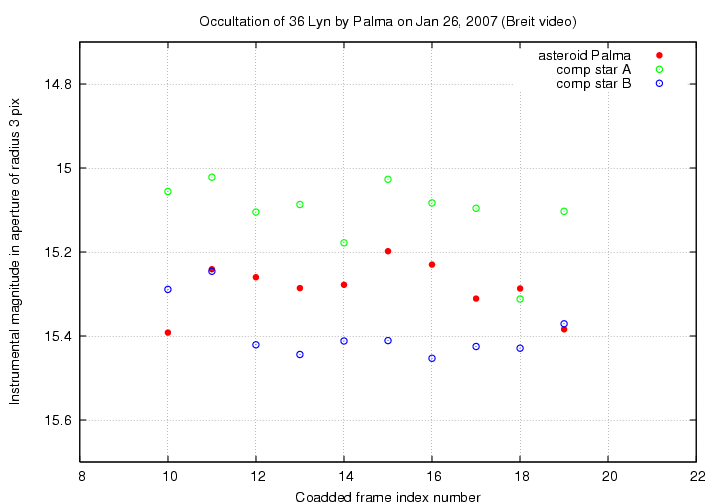
On UT 2007 January 26, the asteroid (372) Palma occulted the bright star 36 Lyncis for observers across the US.
Derek Breit observed this event from Anderson, California.
Derek asked me if I could use his videotape to determine the magnitude of the asteroid relative to a pair of comparison stars in the field. I did my best, but (as you will see below), the results aren't very precise.
Derek placed a digitized version of his video record on his web site. The movie was in MPEG-PS format, with frames 720x480 pixels in size. I chopped the movie into individual frames using mplayer. Each frame became a JPEG image, 720x480 pixels in size, in 24-bit color. The actual pixel values, however, represent an 8-bit greyscale palette.
For example, here is frame number 1 of the video. The field of view is roughly 20 arcminutes wide (North-South) by 13 arcminutes high (East-West). I've flipped the orientation so that the timestamps are upside down.

The three objects are
label object TASS V TASS I ------------------------------------------------------------------------------ A Palma + 36 Lyncis ---- ----- B TYC 2489-934-1 10.10 +/- 0.07 9.33 +/- 0.08 C TYC 2489-841-1 10.47 0.07 9.39 0.09 ------------------------------------------------------------------------------
I show the TASS Mark IV magnitudes for the two stars. Neither one shows any evidence for variability on long time scales.
Now, the image of 36-Lyncis-plus-Palma is very saturated. When the asteroid covers the star, however, the asteroid's image alone is not saturated, but roughly equal in brightness to the two stars; all have peak values of about 130 counts per pixel, which is far from the limit of 255 counts per pixel imposed by the 8-bit movie.
In order to see more details, I co-added 50 frames. A sample coadded image is shown below. Note the strong change in the background properties across the field:

The central portion of the frame has a slightly higher background, and a much high scatter in background levels, as this histogram of pixel values shows:

I fear that any comparison of the target asteroid -- in the central region -- to the comparison stars -- in the outer region -- will incur a significant, unknown systematic error.
So, keep that in mind as I continue.
I coadded sets of 10 consecutive frames to create a set of deeper images. I started with frame 100 of the movie, adding frames 100-109 to create deep image number "10", then adding frames 110-119 to create deep image number "11", and so forth, up to adding frames 190-199 to create deep image number "19". In all of these frames, the asteroid covered the star completely, so that only the asteroid's light appears.
I then used the XVista image processing package to measure the instrumental magnitude of the three objects: comp star B, comp star C, and the asteroid Palma. I subtracted a local sky background determined from an annulus around each object. The FWHM of the images was about 3.5-4.0 pixels, and I found that a small aperture of radius 3 pixels yielded the most consistent results.
However, the "most consistent" results were not very consistent. Below are light curves of the three objects over the span of 100 video frames = 10 coadded frames. Note the large variation in the relative brightness of each.

The statistics of these results yield differential magnitudes of
object instr. mag diff (B - obj)
mean stdev
------------------------------------------------------------------------
star C -0.28 0.08
asteroid Palma -0.18 0.10
------------------------------------------------------------------------
In other words, the coadded frames indicate that star B was 0.28 mag brighter than star C, but with quite a large uncertainty.
Comparing the measurements of the two comparison stars to the TASS magnitudes, we see that the instrumental system lies in between the V-band and I-band differences, but a bit closer to V-band. One might speculate that it might be reasonable to compare the video record to V-band.
We might therefore conclude that the asteroid Palma was 0.18 magnitudes fainter than star B in the V-band:
Palma magnitude "V" = 10.28 +/- 0.30 ???
Remember the unknown systematic error due to the variation in the background/sensitivity of the images.
For comparison, the JPL Horizons system provides a "magnitude" of 10.57 for the asteroid during this time.